London doss-houses
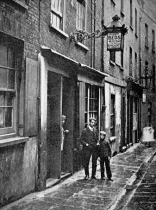
A Chelsea house I researched recently was used as a 6d-a-night doss-house from 1890, combined with the house next door. The 1891 census recorded 99 men lodging there and similar numbers ten years later. One of the lodgers was the aptly-named Samuel Rook, whose occupation was listed as 'thief'.
Common lodging houses or doss-houses were notorious for their over-crowding. The lodgers often dispensed with bed linen, if there was any, to escape vermin. The daily fee bought a bed, or in many cases a share of a bed. Some establishments operated a two-relay system where a bed was occupied by one person during the day and another at night. In some cases a three-relay system shared a bed in eight-hour shifts.
The American author Jack London, disguised as a stranded sailor on a research trip to London in 1902 described the horrors he encountered at a doss-house: 'The entrance was by way of a flight of steps descending from the sidewalk to what was properly the cellar of the building. Here were two large and gloomily lighted rooms, in which men cooked and ate. I had intended to do some cooking myself, but the smell of the place stole away my appetite, or, rather wrested it from me; so I contented myself watching other men cook and eat. One workman, home from work, sat down opposite me at the rough wooden table, and began his meal. A handful of salt on the not over-clean table consituted his butter. Into it he dipped his bread, mouthful by mouthful, and washed it down with tea from a big mug. A piece of fish completed his bill of fare. He ate silently, looking neither to right nor left nor across at me...I ventured to the range where the men were cooking. But the smell I had noticed on entering was stronger here, and a rising nausea drove me into the street for fresh air.'
In 1894 the licensing and inspection of London doss-houses passed from the police to the London County Council, which in 1902 obtained additional powers. The appointment of doss-house managers was subject to official approval, inspections could be made in the middle of the night, and improvements were made in sanitation, ventilation and the minimum space required for each bed. Painting of interiors rather than white-liming was introduced to reduce vermin, and sheet-changing once a month was no longer permitted.
On the train to Delhi
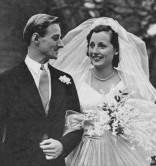
In Februrary 1948 the Hon. Wentworth and Sarah Beaumont had a grand society wedding, attended by the Queen and Princesses Elizabeth and Margaret, before moving into their new Chelsea home.
Wentworth Beaumont was still only 26 but had already lived an eventful life. During the Second World War he flew 71 Spitfire missions until, in 1942, he was shot down off the coast of Northern Holland, suffering a severe leg injury. He was captured and sent to Stalag Luft III in Silesia, the setting for what was to be immortalised in the cinema as The Great Escape. More than 80 Allied prisoners tunnelled their way out of the camp in March 1944, many to be murdered by the Gestapo after they were recaptured. Hampered by the after effects of his injury, Beaumont was not able to join the escape party. But he was a member of the map-making team.
On returning to service in 1946 he was appointed ADC to the Viceroy of India, serving first Lord Wavell and then Lord Mountbatten. In August 1947, with his fiancee Sarah, daughter of General Lord Ismay, Mountbatten's chief of staff, Beaumont accompanied the Viceregal party to Simla on holiday. The young couple then left by train to return to Delhi, before travelling back to England. According to Lord Ismay's vivid memoir: 'When they boarded the train, Wenty's Muslim servant showed signs of panic and was given permission to travel in their carriage. Nothing unusual happened until, at Sonepat station, about 20 miles from Delhi, a bomb was exploded on the platform. This was apparently the preconcerted signal for a general attack on all Muslim passengers. Men, women and children were pulled out of the train by their Hindu fellow travellers and butchered in the most brutal manner. At this point, Wenty hid the servant under the seat and piled suitcases in front of him. A little later, two well-dressed and seemingly well-educated Hindus presented themselves at the door of his carriage and demanded the right to search for a Muslim who was believed to be with them.
'Wenty indignantly refused, and the intruders took themselves off. Maybe they were impressed by Wenty's ADC armband, or by the two revolvers which he and Sarah were flourishing. The servant, who had fainted from fright and kept a deathly silence, was the only Muslim to arrive at Delhi.'
A sunken bath in Bayswater
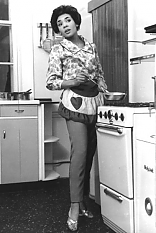
I've just been researching a house in Bayswater built in 1830 which had several interesting residents. In 1959 it became the home of Shirley Bassey. It was the first house she had ever bought and was clearly a big step forward for her, as she explained to a Daily Mail reporter she invited over. After the journalist had been told the cost of the house - £12,000 - and the ornate door knocker - £50 - Bassey showed her the feature she was most proud of, a pale-pink sunken bath, and explained that as a child she had never even had a bathroom.
Hers was a proper rags-to-riches story. She was born in 1937 in the boondocks of Tiger Bay in Cardiff. While in her teens she started to perform in local pubs and clubs; and on leaving school (and finding herself pregnant at the age of sixteen) she took a job in a local factory while continuing to perform whenever opportunity arose. By 1959 - when she was photographed in her new kitchen - she had acquired a music company, owned two houses (one she bought for her parents), had a £4,000 red and cream Chevrolet sports car, a mink, diamonds and a white poodle with a jewelled collar called 'Beaujolais'. Bassey's manager Mike Sullivan recalled his first visit to the house: 'A bing-bong version of her hit song As I Love You chimed out as I pressed the front door button to the narrow terraced house just a few yards from Hyde Park. Gerda, the German housekeeper, opened the door and I forced my feet through the deep pile of red carpeting which covered the hallway and stairs until I reached the first landing. Shirley stood at the door of the first-floor sitting room wearing an ankle-length brown robe and a haughty man-eating expression.'
Robert Elms Show 27.6.17

Angela Lownie interviewed about house history of South Kensington on BBC Radio London - listen for a limited time only on the following link (16 minutes into the programme)
Fanny and Stella
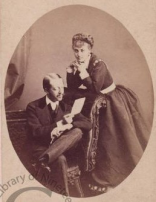
In the 1860s Lord Arthur Pelham-Clinton lodged at a house I researched in Westminster. He was a son of the Duke of Newcastle, godson to the Prime Minister William Gladstone and MP for Newark. He was in his late twenties, slightly built and inclined to stoop. The top of his head was already bald as an egg, a fact he disguised by a comb-over, plastered with hair oil.
Pelham-Clinton was declared bankrupt on 12 November 1868 with debts and liabilities of £70,000 (about £5.68 million today), and stood down as an MP. Bankruptcy was not the only notoriety attached to him. From 1867 he was associated with a transvestite, Ernest Boulton (aka Stella) who had dressed as a girl from a young age with the support of his mother. Boulton and Frederick Park 'Fanny' often appeared in public in female dress and on 28 April 1870 they were arrested and charged with 'conspiring and inciting persons to commit an unnatural offence' with Pelham-Clinton and others.
As the evidence unfolded, it was clear to everyone that Pelham-Clinton was heavily implicated. He had performed in public theatricals with Boulton and astonishingly had lived with him as man and wife. There were compromising letters, suggestive photographs and several sworn statements.
Pelham-Clinton officially died on 18 June 1870, the day after receiving his subpoena for the trial, ostensibly of scarlet fever but more probably a suicide. But at that time there was considerable speculation that he had used his powerful contacts to flee abroad. Boulton and Park were acquitted.
London House Histories on Radio Gorgeous

Angela Lownie the House Detective gives an interview on Radio Gorgeous - shameful marriages, hangings and a double murder...
Witches' marks
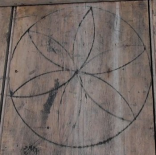
A symbol like this one was scorched into the staircase timber of an early Georgian house I've just researched in Hampstead. The symbols, also known as apotropaic marks, most commonly took the form of a 'Daisy Wheel' which was drawn with a compass in a single endless line which was meant to confuse and entrap evil spirits. The patterns include flower-like designs, pentangles and tangles of lines to flummox spirits that attempted to follow them. These witches' marks can be found on houses, churches and barns built between about 1550 and 1750 - often near an entry point of the building or the staircase down to the kitchen.
The marks were thought to offer protection and coincide with a period when belief in witchcraft and the supernatural was widespread. Interiors lit by tallow candles would have been eerily dark once night fell.
Tyburn tree and Oliver Cromwell
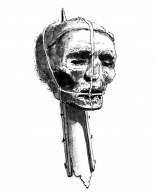
Sometimes gruesome stories emerge, such as the discovery that a house in Connaught Square I researched was most probably on the exact site of the infamous gallows at Tyburn. This fact was particularly mentioned in the original lease granted by the Bishop of London. One other grisly detail: it's likely that various parts of Oliver Cromwell are buried beneath the house. When his body was disinterred from the tomb of kings in Westminster Abbey in 1660, he was then posthumously hung from the gallows at Tyburn and his body buried there. His head, however, went on a tour of England, before being buried - finally - in Sidney Sussex College, Cambridge. It's debatable whether some people would want to know all this, but luckily it didn't worry the owner of the Connaught Square property in the slightest.
Suicide from the harsh conduct of a tax collector
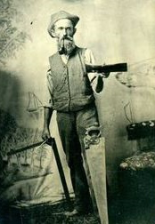
I came across this 1847 headline only recently, which refers to a seventy-nine year old carpenter, John Wright, who lived for forty years in my own house in Westminster. One Saturday afternoon, the local tax collector's broker came to the house with a warrant to seize property for 18 months' taxes, amounting to £9. He was let in by John Wright's sister and made an attempt to open the front parlour which was occupied by lodgers. He then 'bounced upstairs' to the first floor and began taking an inventory. John Wright asked him to wait for three hours and he should be able to settle the demand, which was refused. An hour later the old man was discovered in his workshop behind the house suspended from a beam. At the inquest the jury returned a verdict of 'Temporary insanity, caused by the harsh measures adopted by the tax collector.'
The verdict of temporary insanity was an important one. Religious sanctions against suicide would remain strong throughout the 19th century, and for a death to be declared 'felo de se' (felon of himself), an old legal term for suicide, it had to be proved the person was sane. Until 1823 in Britain, such suicides were denied a Christian burial - and instead were buried at a crossroads in the dead of night, a wooden stake hammered through the body pinning it in place. And punishment did not end with death. The deceased's family were stripped of their belongings which were handed to the Crown. The suicide of an adult male could reduce his survivors to pauperism.
If a suicide could be shown to have been carried out when the victim was of unsound mind or uncertain mental state, the legal requirements were different. The individual could be buried in a churchyard, usually in a specially designated area or near the boundary. Until 1882, suicides by law had to be buried between 9pm and midnight.
John Wright was buried in the churchyard of St. Margaret's Westminster in November 1847. There were 300 burials that year and complaints were made about the obnoxious state of the burial ground. Coffin remnants were heaped to one side and the smell was sickening, according to 'The Builder'. The ground was eventually closed for burials in 1853.
Serendipity and an unpaid fish bill
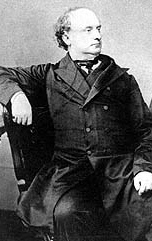
An early resident of a house I have just researched in Kensington was Ernest Jones, one of the most prominent figures in the Chartist movement in the 1840s and 1850s. His speeches, in which he openly advocated physical force, led to his prosecution, and he was sentenced in 1848 to two years' imprisonment for seditious speeches. While in prison he wrote, it is said in his own blood on leaves torn from a prayer book, The Revolt of Hindostan, an epic poem.
Upon his release from prison he became a leading figure in the National Charter Association and helped to give the Chartist movement a clearer socialist direction. He knew Karl Marx and Friedrich Engels personally. Marx and Engels at the same time commented on the Chartist movement and Jones' work in their letters and articles.
He is believed to have sacrificed a considerable fortune rather than abandon his Chartist principles.
A further fact about Ernest Jones is that he didn't always pay his fishmonger - this was extremely lucky as it happens and was the only clue to his identity when I was researching his Kensington home. Entries in the rate books and directories of an 'Ernest Jones' provided little guidance and the family was unluckily away at the time of the census. It was only when I chanced upon an article in the press about an argument between Jones and his fishmonger that everything fell into place. This is why house historians are often called 'house detectives'!
A Victorian business

I have recently researched the history of Charbonnel et Walker - founded in 1875 and one of Britain's first chocolatiers. Reputedly encouraged by Edward VII, the business was formed as a partnership between Virginie Charbonnel and Minnie Walker, both from the esteemed Maison Boissier chocolate house in Paris. The company found favour with royalty and the rich and famous from the outset, who bought chocolate and novelties from the shop, and frequented the Salons de The for coffee, ices, cakes, tea and refreshment. Prince Francis of Teck courted his mistress with Charbonnel et Walker chocolates, before bequeathing the Teck emeralds to her - these were discreetly bought back by Queen Mary for a large sum. Other customers have included Princess Margaret, Wallis Simpson, Sir John Gieldgud, Sir Alec Guinness and Noel Coward.
The Phoney War in London
Writers invariably describe their home and surroundings in an evocative way - this is immensely helpful to house historians and I am always delighted to find that a novelist has lived in a house I am researching!
E.M. Delafield lived in a flat above her literary agent's offices just off the Strand during the autumn of 1939. Her largely autobiographical The Provincial Lady in Wartime describes the house and brilliantly captures the mix of apprehension, confusion and plain boredom which made the first months of the Second World War so trying. Delafield worked as a volunteer canteen helper at the Adelphi ARP Station. The passages describing this establishment with its motley staff and customers during the phoney war, with food still plentiful and no urgent incidents to deal with, carry the ring of authenticity: 'Trousered women are standing and walking about in every direction, and a great many men with armlets... Rather disquieting notice indicates directions to be taken by Decontaminated Women, Walking Cases, Stretcher-bearers and others... Atmosphere thick with smoke and no apparent ventilation.'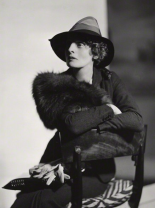
Angela Lownie article appears in Pall Mall Art Advisors' Newsletter

An article by London House Histories' Angela Lownie is featured in Pall Mall Art Advisors newsletter.
A big bonfire
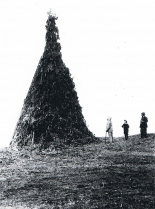
Queen Victoria's Golden Jubilee was celebrated on 20 and 21 June 1887. The Queen celebrated with a big banquet at Buckingham Palace in the evening. Fifty foreign kings and princes attended, along with the governing heads of Britain's overseas colonies and dominions. She wrote in her diary of the event: 'Had a large family dinner. The King of Denmark took me in, and Willy of Greece sat on my other side. The Princes were all in uniform, and the Princesses were all beautifully dressed. Afterwards we went into the Ballroom, where my band played.' The rest of the country also held celebrations and lit beacon bonfires, including this enormous one at Valence estate near Westerham in Kent. My latest research is on a Victorian estate cottage at Valence - for me an unusual and fascinating diversion from London properties.
World War I horses
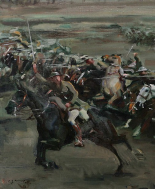
Looking at the occupants of a single house can open up much wider events in the past - it's micro personalised history with which we can identify. During the First World War a resident of a Connaught Square house I am researching travelled continuously on behalf of the Army Remount Service to buy horses as remounts in the USA, Canada, Australia and New Zealand. These buyers had to have a good deal of equine experience so as not to be conned into buying 'duds'. 3 million horses were engaged in the war by 1915; however it was estimated that the average life of a horse on the firing line in Belgium and France was about ten days. Artist A.J. Munnings was also involved with the Army Remount Service, at first processing tens of thousands of Canadian horses en route to France. Later he was assigned to one of the remount depots on the Western Front.
News Archive
- A big bonfire
- A sunken bath in Bayswater
- A Victorian business
- Angela Lownie article appears in Pall Mall Art Advisors' Newsletter
- Fanny and Stella
- George IV's last mistress
- London doss-houses
- London House Histories in the Press
- London House Histories on Radio Gorgeous
- London’s oldest remaining mansion blocks
- Mount Street research reveals early links with Percy Bysshe Shelley
- On the train to Delhi
- One of Mayfair's oldest houses
- Robert Elms Show 27.6.17
- Serendipity and an unpaid fish bill
- Suicide from the harsh conduct of a tax collector
- The Phoney War in London
- Tyburn tree and Oliver Cromwell
- Witches' marks
- World War I horses
